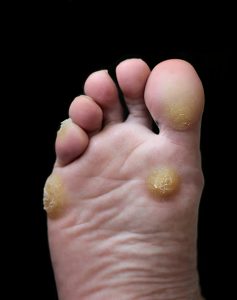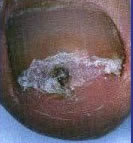Corns & Callouses
Corns & Callouses
We advise against the use of corn removing plasters which are found in many chemist shops. These contain an acid which is intended to break down the corn and allow it be scraped off of the foot. However, the acid is often too strong for the corn and destroys not only the corn but the underlying tissues as well. This is a very unpleasant experience which results in an acid burn to the skin and occasionally infection as well.
 Hard skin develops anywhere that there is an excessive pressure or friction over the skin. This is a protective mechanism whereby the body’s response to the pressure or friction is to create a layer of hard skin, thereby shielding the underlying tissues from the forces sustained. This is perfectly normal and usually completely trouble free; for instance, people often find a thickened area of skin on their fingers where they hold a pen or wear a ring. However, if the skin thickens up too much, it becomes painful as it presses onto the tissues underneath. On the foot this often occurs either where a shoe might rub against a toe (e.g. “little” toes rubbing against the narrow toe box in a court shoe) or where too much weight is taken on the ball of the foot, such as in a stiletto shoe where the foot is constantly sliding down the slope from the heel to the forefoot.
Hard skin develops anywhere that there is an excessive pressure or friction over the skin. This is a protective mechanism whereby the body’s response to the pressure or friction is to create a layer of hard skin, thereby shielding the underlying tissues from the forces sustained. This is perfectly normal and usually completely trouble free; for instance, people often find a thickened area of skin on their fingers where they hold a pen or wear a ring. However, if the skin thickens up too much, it becomes painful as it presses onto the tissues underneath. On the foot this often occurs either where a shoe might rub against a toe (e.g. “little” toes rubbing against the narrow toe box in a court shoe) or where too much weight is taken on the ball of the foot, such as in a stiletto shoe where the foot is constantly sliding down the slope from the heel to the forefoot.
In cases where the pressure or friction is either concentrated in a small area, or where the hard skin thickens up to an extreme degree, a central nucleus of particularly hard skin forms into a small core. This core is as hard as bone or nail and often feels like a stone or small piece of grit trapped inside a shoe. This is known as a corn, and although they are commonly found on toes and the balls of the feet (see above picture) they can occasionally occur in less predictable places, such as underneath a toe nail (see picture opposite).
 In the early stages of hard skin or corn development we recommend the daily use of a quality moisturising cream in order to keep the skin soft and supple. A pumice stone or similar abrasive device should be used one or two times a week when in the bath to remove any build up of hard skin. If followed regularly, these procedures will prevent the hard skin (also known as “callous”) from building up to the point where it becomes painful. If the problem has developed too far for the above advice to be practical, we suggest that you contact the practice for an appointment to have it professionally treated.
In the early stages of hard skin or corn development we recommend the daily use of a quality moisturising cream in order to keep the skin soft and supple. A pumice stone or similar abrasive device should be used one or two times a week when in the bath to remove any build up of hard skin. If followed regularly, these procedures will prevent the hard skin (also known as “callous”) from building up to the point where it becomes painful. If the problem has developed too far for the above advice to be practical, we suggest that you contact the practice for an appointment to have it professionally treated.
